

Many coaches, consultants, and other experts decide to create an online course and dive headfirst into content creation, missing one common critical step: getting to know their audience.
They underestimate the importance of audience research, which ultimately leads to a lack of success. Or, they fail to attain the level of online success they might otherwise have had if they’d only taken the time to research their audience before creating content for their course.
Audience research is the key to ensuring that your learners get what they need from your course or other educational offering. It allows you to create relevant content and guarantees you have a product or service that is actually in demand.
In this guide, we take a look at what audience research is, why it’s important, and the steps you can take to learn more about your target audience so you can set up a strong foundation for your new course.
Let’s dive in.
What is Audience Research?
Audience research is the systematic process of gathering information and insights about a specific group of people who are the intended recipients or consumers of a particular product, service, or message.
This research aims to understand the characteristics, behaviors, needs, preferences, and attitudes of the target audience.
As a course creator, you must be able to answer these questions about your business:
- What is your niche?
- Who’s your audience?
- What’s their biggest pain point/problem?
- How can you help them?
Audience research helps you answer all these questions effectively.
Think back to when you first started your online business. You probably did some research by searching on Google, reading blog posts, listening to relevant podcasts, and checking out content on social media before starting your business.
The same is true for your online course, except this time you need to research your potential learners so you can understand their pain points and tailor your content to address their needs and preferences.
Why Is Audience Research Important?
Conducting audience research is important for several reasons. For starters, it helps you determine if there is a need for what you have to offer. It also leads to more personalized learning, increased engagement, and can even be used to identify future e-learning trends.
When used in the online marketing and education fields, audience research can help you develop content and strategies that resonate with your intended audience.
As a course creator, you’ll be better able to help your learners achieve the desired results, which leaves them satisfied and likely to become a return customer.
You can also use audience research to design curriculums and create materials and teaching methods that match the learning preferences and needs of your students.
When learners are happy, they are more likely to recommend your course to others and to purchase your future offerings.
Additionally, audience research can be a valuable marketing tool that can help your business tailor its online course marketing strategies to reach specific customer segments more effectively.
Ignoring this crucial step produces a vague learning experience and fails to accomplish set learning goals. For the most part, learners are disengaged because their experience is not well-curated based on their particular needs.
Key Aspects of Audience Research For Course Creators
Before you start your research, it’s important to understand the key aspects of audience research so you can focus on gathering the right information to inform your business decisions.
Key aspects of audience research include:
- Demographics: This involves collecting data on the basic characteristics of your audience, such as age, gender, location, income, education level, and occupation.
- Psychographics: Analyzing the audience’s values, lifestyles, interests, attitudes, and motivations. This information provides insights into their behaviors and decision-making processes.
- Feedback and Surveys: Collect direct feedback from the audience through surveys, questionnaires, and feedback forms to understand their opinions, needs, and suggestions.
- Competitive Analysis: Evaluating how the audience engages with competitors and their products or content. This helps identify gaps and opportunities.
- Media Consumption: Understanding the media channels and platforms the audience uses to consume information, such as websites/blogs, podcasts, video sites, and social media.
- Content Preferences: Identifying the type of content, topics, and formats that resonate with them. This can include their preferred content length, style, and tone.
The goal is to deeply understand your target student’s problems, goals, and preferred learning styles.
The rest of this guide focuses on multiple research tactics to help you gather information in each of these categories so you can discover precisely who your audience is, what their pain points are, and how you can create course content that addresses their problems effectively.
How to Conduct Audience Research For Course Creators
Below are the different techniques to gather the information you need to help you find the ideal audience for your online course.
As you conduct your analysis, keep the following questions in mind:
- What are your audience’s goals/objectives/desires? What do they hope to achieve by taking your online course?
- What are their interests and needs? What do they want to learn more about? What are they struggling with?
- What are their pain points? What challenges are they facing that your course content can help them overcome?
- What is their level of expertise? How much do they know about your course topic?
- What are their preferred learning styles? Do they like to learn via videos, audio, or text formats?
- What are their constraints? What resources do they have access to, and do they have the time to complete your course?
- What are their motivations to learn? Why do they want to take your course?
Keep an organized record of the information you gather, including statistics, quotes, and trends. This will make it easier for you to analyze your findings to gain valuable insights once you’re done.
Step #1: Gather Existing Data
The first step in researching your audience is to gather data that already exists. Audience research can be broken down into two categories: Primary and Secondary research.
Primary research is any data that you collect first-hand. It’s an effective way to analyze your audience. This can be through things like surveys, interviews, and online polls, and can be either qualitative (focused on the feelings and opinions of your audience) or quantitative (focused on statistics and hard facts).
Secondary research involves gathering, consolidating, and summarizing research and data that already exists. For instance, it might involve digging into course marketing statistics, trend reports, competitors, and content on the e-learning industry from research agencies and sites like Statista, Gartner, and Forrester.
Gathering information that already exists helps you to find gaps or underserved areas in your niche that present opportunities for you to offer valuable solutions. Secondary research is also useful for analyzing your competitors so you can learn from their mistakes and find ways to differentiate yourself.
So where can you gather existing data to research your online course? Well, there are many sources:
1. Google
The first step in understanding the online learning arena and its communities is to find answers to the following essential questions:
- Who is your potential audience?
- What digital platforms do they use?
- What are their buying behaviors?
- Where do they live?
- How do they (or how will they) interact with you effectively?
- What are the different genders, age groups, and nationalities of your target audience?
- What type of content do they enjoy and share?
- What is their education or experience level?
A simple Google search is the best way to begin your research.
Google your course topic, as well as any related words and phrases. Look at the results and see which sites are popping up.
Are there any similarities that you can notice? Does there seem to be a certain group of people interested in your topic?
For example, say you wanted to create a Forex Trading Course. A simple search on Google will show you that there are beginner, intermediate, and advanced courses available. By looking through the results, it’s clear that most people focus on “making money” rather than working to get the right mindset to become a consistently profitable trader.
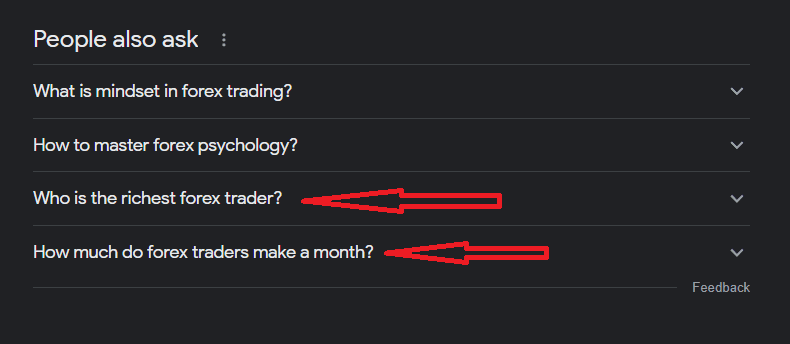

There is an obvious gap in the market, which means an opportunity for you to position your online course as the solution to how mastering your mindset can lead to increased profits in Forex trading.
In addition to conducting simple searches on Google, there are many other online sources you can look to when conducting secondary research into your audience.
These include:
- Industry content
- Trend reports
- Market statistics
- Sales data (if available)
Websites like eLearningIndustry.com, LearningGuild.com, and eLearningLearning.com offer a wealth of articles, news, reviews, and resources related to online learning.
Remember that the e-learning industry is dynamic and constantly evolving, so staying updated with a variety of sources will help you gain a well-rounded understanding of the field. Additionally, consider subscribing to newsletters or setting up RSS feeds for your preferred sources to receive regular updates in your inbox.
2. Social Media
Many educators and e-learning professionals share their knowledge and insights on social media platforms like Facebook, Twitter, LinkedIn, and Instagram.
Many have YouTube channels where you can find video content on e-learning topics, tutorials, and case studies.
Part of your research should be focused on these platforms. As you browse through each one, analyze discussions and content. Pay close attention to the most discussed topics, frequently asked questions, and popular content within the community. This will help you identify the most pressing issues your course can address.
What questions are people asking about your topic? Dig into their profiles to discover what other things they are interested in. Find out where they spend their time. Dig as deeply as you can and learn as much as possible about these people. And, while researching, do your best to make predictions about who they are.
Another way to gather information is to monitor comments and feedback on all relevant social media platforms where your intended audience hangs out.
Sites like LinkedIn and Twitter, in particular, can be excellent sources for e-learning industry content. You might even go a step further and follow e-learning experts, organizations, and hashtags on these platforms to get real-time updates and engage in discussions.
Note: If you already have a blog, pay attention to previous comments and feedback on your posts.
3. Online Forums and Discussion Groups
Using online forums and discussion groups is an effective audience research method to gather insights, understand your target audience, and create a more tailored online course.
There are peer-to-peer discussion groups and forums in virtually every profession on platforms like Reddit, Quora, LinkedIn Groups, Facebook Groups, and specialized forums.
The example below from Quora shows that there are users in the self-development space looking to learn about public speaking. This presents an opportunity for a course creator in that niche.
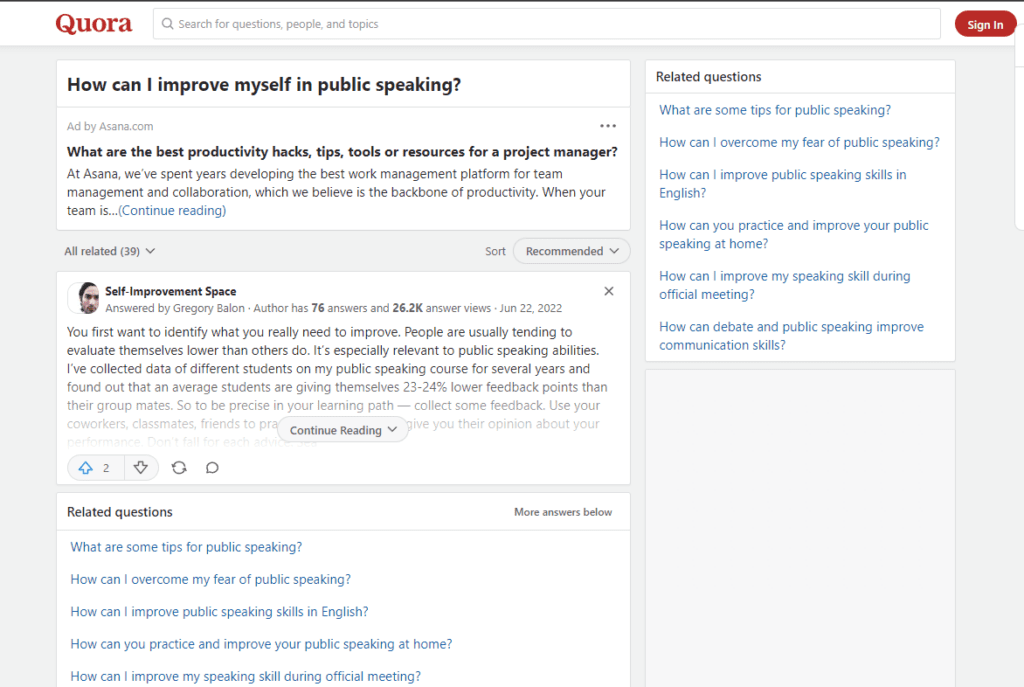

Find relevant groups and listen in to learn more about the interests of your intended audience. You’ll be able to get deep insights into the desires, hopes, aspirations, fears, and daily struggles of your potential customers.
This research tactic will also help you validate your idea and solidify your niche if you haven’t done so already.
For example, if you are having trouble finding forums or groups in your subject range on sites like Quora or Reddit, then it’s a sign that you may have gone too niche with your topic, and you may consider broadening your focus a little.
4. Blogs and Online Resources
Blogs are another great source to learn about online courses and e-learning platforms with regard to audience research. For instance, the official blogs of Coursera and edX often feature articles on trends and innovations in the e-learning space.
Unlike groups and forums, successful e-learning blogs are run by industry leaders who typically have advice columns and thought pieces to share.
These can also give you insight into the types of audience you want to target – what content they like, the formats they prefer, social media platforms where they hang out most, and so on. You can also use this research to help inspire your own course and blog content.
This step also ties in with the competitor research that you will perform as some of your competitors will have blogs from which you can glean important insights to learn from.
5. Competitor Analysis
Audience research for your online course also involves researching any competitors who offer similar online courses. Competition is generally a sign that there’s a strong market. It indicates an interest in your type of course and content.
Come up with a list of competitors who offer similar online courses. Shortlist your main competitors to make it easier for you to analyze their strengths, weaknesses, and strategies.
You can use tools like SimilarWeb or SEMRush to analyze things such as their:
- Course content
- Pricing strategies
- Customer reviews
- Blog comments
- Site traffic
- Social media presence
- Keywords
- Content marketing strategy
Analyze competitor courses and read their reviews. See what students liked, didn’t like, and felt was missing. This can reveal gaps or opportunities for your own course.
Analyze competitor marketing strategies, including promotional materials, sales funnels, and free content to see what marketing efforts attract their audience. Have a look at how their campaigns are performing and try to find ways you can stand out from them.
You don’t want to copy them in every respect, but there are a lot of things you can learn from this type of research. It can help you identify gaps in the market and highlight areas with opportunities for you to differentiate your course.
Your competitor analysis will also help you find ways to turn their weaknesses into strengths and open up opportunities to offer something unique to your own audience.
Important Note: This research can help you structure your course properly, and it can help you avoid making some of your competitors’ mistakes, and save you (and your future learners) a lot of time and frustration.
However, if you’re not careful, it can also turn into a case of the blind leading the blind. If your competitors haven’t done proper market research, you may find yourself going down the same path and repeating their mistakes, as opposed to learning from them.
6. Google Analytics
Google Analytics is another important source of secondary data. The platform allows for data collection, analysis, and monitoring. You get in-depth reports, as well as integration with other applications to get even more marketing or sales insights into your business.
The graph below from Databox shows that Google Analytics is one of the most popular audience research techniques used by the majority of researchers to learn more about their audiences.
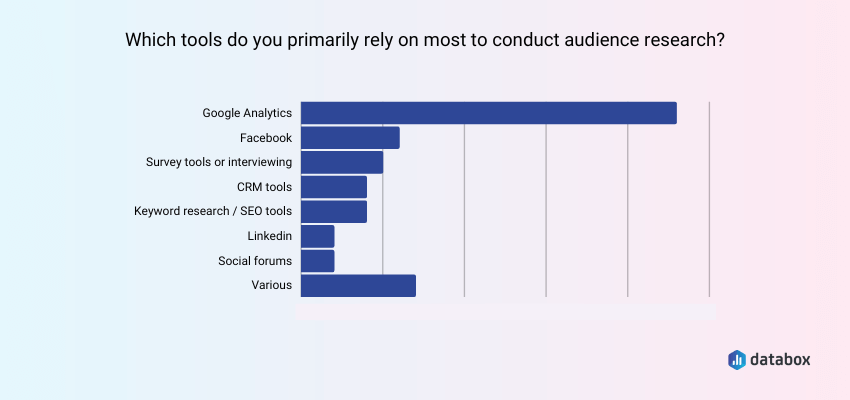

You can use the information from the free website analytics platform to understand how many people visit your site, and how they behave while navigating your pages. You’ll be able to identify patterns and trends pertaining to how visitors engage with your website and content.
Here are some of the things Google Analytics is capable of showing you:
- See what countries and cities users are visiting your website from
- Find out the devices the audience uses
- Discover your audience’s interests
- Find out which channel drives the most traffic to your website
- Keep track of your marketing campaigns
- See how users navigate your website
- Check which of your content is the most popular
- Figure out the conversion rate of your website
- Track your top-selling products and see who buys them
But perhaps most importantly, Google Analytics allows you to segment and slice website activity so you can see specific users.
As an online course creator, you need to be able to isolate and segment subsets of users so you can provide super-relevant content to each segment.
With Google Analytics (or any other web analytics tool), you’ll be able to track visitor behavior, gather information about the behavior of visitors to your website, and understand which pages they visit most, as well as how long they stay, and where they drop off. This is important data that can give you a clear indication of their interests and pain points.
Step #2: Ask Your Target Audience Directly
Finding your target audience isn’t just about knowing their age, gender, interests, and other demographics – although these are important factors that help you choose appropriate subject matter.
You also need to know about the life experiences of your potential learners. You need to be able to understand what brings them to your course and how you can connect with them and help them achieve their goals through the lessons you create and the examples you use.
One of the best ways to find out this information is to ask your audience directly.
If you already have a dedicated audience willing to share feedback, this step will be easy. Simply reach them on your blog, social media, or via email.
But what if you’re just starting out? What if you are looking to launch your first course but haven’t built an audience yet? Well, even then, you at least have a general idea of the type of person you want to sell your online course to. All you have to do is find these people online and use the methods below to learn about their needs.
In such a situation, you have to find the balance between:
- Decidingon the type of audience you want to attract; and
- Respondingto the interests and demands of that audience.
You’ll have to refine your audience research as you learn what the interests of your audience are. However, as you start to fill in the broader picture of your audience, you’ll be better able to build a course that matches exactly what they want – even as a first-time course creator.
With that said, here are the ways to achieve this.
1. Surveys and Questionnaires
Surveys, questionnaires, and polls are powerful audience research tools that you can use to gather insights directly from your entire audience, as well as your target audience to discover the solutions they’re seeking.
You may be an expert in your field, but you may not know precisely what subjects your audience wants to learn about within your area of expertise.
For example, you may have been planning to create a course on the fundamental aspect of good photography, but after researching your audience, you discovered that they wanted more education on ways to edit their photos for a professional look. Your subject of choice, while valid, wasn’t what the audience wanted.
Online surveys and polls can help you avoid wasting time creating content that no one wants and they also make it easier for you to choose effective ways to market your course.
You can use tools like Google Forms or SurveyMonkey to design and distribute surveys to gather quantitative and qualitative research data from potential learners.
The tools are intuitive to use and come with pre-made survey and questionnaire templates that are ready to use. Simply swap out the placeholder content for your own and you’re ready to go.
The image below shows an example of Google’s free customer satisfaction surveys. You can create any type of survey you want for your audience research, and if you already have a course published, you can send customer satisfaction surveys to your learners to get more audience insights.
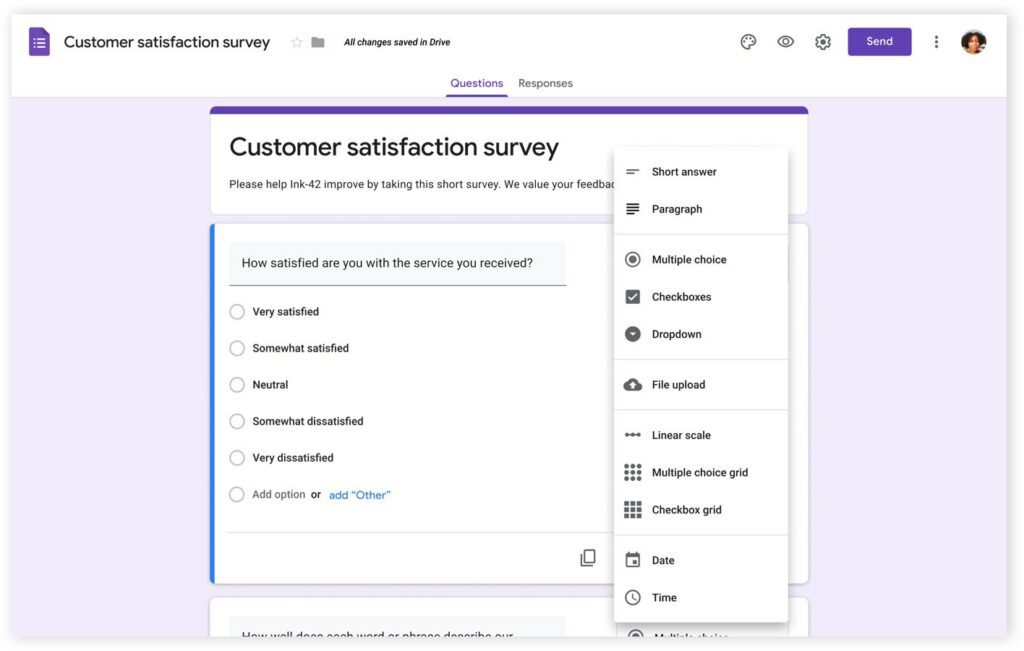

Make sure your survey includes questions about your target learners’ preferences, goals, challenges, and what they expect from an online course.
Ask about their challenges, how they currently solve those challenges and the type of solution they’d ideally like to have.
You might also include questions like what potential learners think of a particular subject if they want to know about a specific topic or learn a specific skill, and what their preferred learning styles are.
Answering these questions will help you determine what your target audiences and ideal learners expect from you.
Once your online course survey is created, it’s time to send it to your target audience. Whether you already have an audience or not, there are a lot of different ways to bring attention to your online survey, including the following:
- Email: Feature the survey in your email newsletter, and personally email audience members you’ve connected with previously.
- Blog Posts: Add it as your main call-to-action in a blog post to collect feedback from your readers on specific topics related to your course content.
- Website Pages: Use the graphic on an opt-in form and add it to your blog sidebar and website pages
- Forums and Groups: If you are part of an online group or forum centered around your area of expertise, those community members can be a great source of feedback.
- Social Media Channels: Create a graphic of your survey and share it on social media. You can also include the survey link to your bios on social media.
The last two research methods are particularly useful if you’re an aspiring course creator who hasn’t yet started building an audience and has no website or mailing list.
Just remember to respect the rules and guidelines of the online forums and discussion groups you’re using for research. Building trust and credibility within these communities is essential for effective audience research.
All in all, online course surveys help you validate your course topic by testing to see if it’s something your audience truly desires. There’s no need to spend weeks (or months) creating something you’re not even sure will sell.
Instead, conducting a simple survey of your customers’ needs helps you gauge interest, gather opinions, and identify the right audience for your online course, as well as what they want to learn to get you started on the right foot.
2. Interviews and Focus Groups
While surveys and polls are insightful on their own, personal interviews offer even higher-quality feedback.
The reason for this is that people are usually more open in interviews, which gives you more insight into their real feelings and opinions than the simple answers they put in a short survey.
You can also ask unique follow-up questions in an interview – something that isn’t possible with surveys. In fact, the interviewee may even steer the conversation in a totally different route than you originally expected, offering you the opportunity to discover new things that you may not have considered previously.
As part of your audience research, conduct one-on-one interviews or focus group sessions with a sample of your target audience. These qualitative methods can provide deeper insights into their motivations and preferences.
Prepare several questions to ask each interviewee. Let them know in advance how much of their time you’re going to need to gather their personal feedback. Interviews of this kind usually take about 10-15 minutes.
As you proceed:
- Ask probing questions: Use open-ended questions to delve deeper into their motivations and needs.
- Record their responses: Take detailed notes.
- Analyze their responses: Look for patterns in their responses.
Things to keep in mind when conducting interviews:
Interview The Right People:
Make sure the interviewees are not only part of your broader audience but that they also fit the description of your target learner. For instance, say you are creating a course on finding post-grad work opportunities through LinkedIn, it doesn’t make sense to interview a 45-year-old professional since they are not your target market.
Offer Incentives:
If you want people to take time out of their busy days to provide you with feedback, it’s a good idea to offer them some sort of incentive. In exchange for their time, you can offer a gift such as a downloadable checklist, e-book, or any other quality freebie that you’ve created.
3. Social Media Monitoring
The next step is to identify the channels of communication that are most appropriate to your ideal audience so you can talk to them in their language, on their preferred platform.
Monitor social media platforms, forums, and online communities where your target audience hangs out. This can help you gather valuable information about their discussions, pain points, and interests.
Join groups on Facebook and search online communities like Reddit and Quora to see what people are already discussing related to your course topic.
Lurk and listen or participate actively.
You can join conversations, make and respond to comments, and engage with your audience to better understand their needs.
Here are some tips to help you:
- Lurk and Listen: Initially, spend some time “lurking” in these online communities. Read discussions, comments, and questions without actively participating. This will help you understand the language, pain points, and interests of your potential learners.
- Participate Actively: Join the forums or groups under your real name and participate in discussions related to your course topic. Engage genuinely, provide helpful insights, and build your reputation as a knowledgeable and trustworthy contributor.
- Ask Open-Ended Questions: Once you’ve established some credibility in the community, start asking open-ended questions related to your course topic. Encourage others to share their experiences, challenges, and suggestions.
- Direct Messaging and Interviews: If community guidelines allow, you can also reach out to individuals through direct messaging for more in-depth conversations or conduct one-on-one interviews to gain deeper insights.
You can use social listening tools like Sprout Social, Sprinklr, or Mention to track conversations, hashtags, and discussions related to your course topic on platforms like Twitter, Facebook, and LinkedIn. This can help you understand current trends and pain points.
In addition to staying abreast of social media updates, you also need to regularly check comments and feedback on your blog posts and course pages. Engage with your audience there, as well, and respond to their questions and concerns to gain a deeper understanding of their needs.
Important Note: When monitoring conversations on social media, keep in mind the things that draw your audience’s attention negatively.
It’s okay to be optimistic. However, being negative can also help guide your audience research. In addition to thinking about what your potential audience wants, you must also think about what they hate. This is powerful information that will give you more chances to attract the attention of the right customers who will be more likely to be satisfied with your course.
Step #3: Consolidate and Analyze Your Data
Now, it’s time to analyze the data you’ve collected so far. Analyzing audience research data is crucial for online course creators to better understand their target audience and tailor their course content and marketing strategies.
Your data analysis will help you to identify trends, patterns, and common pain points. Use tools like Excel, Google Sheets, or data analysis software like Audiense or SparkToro to organize and interpret the data.
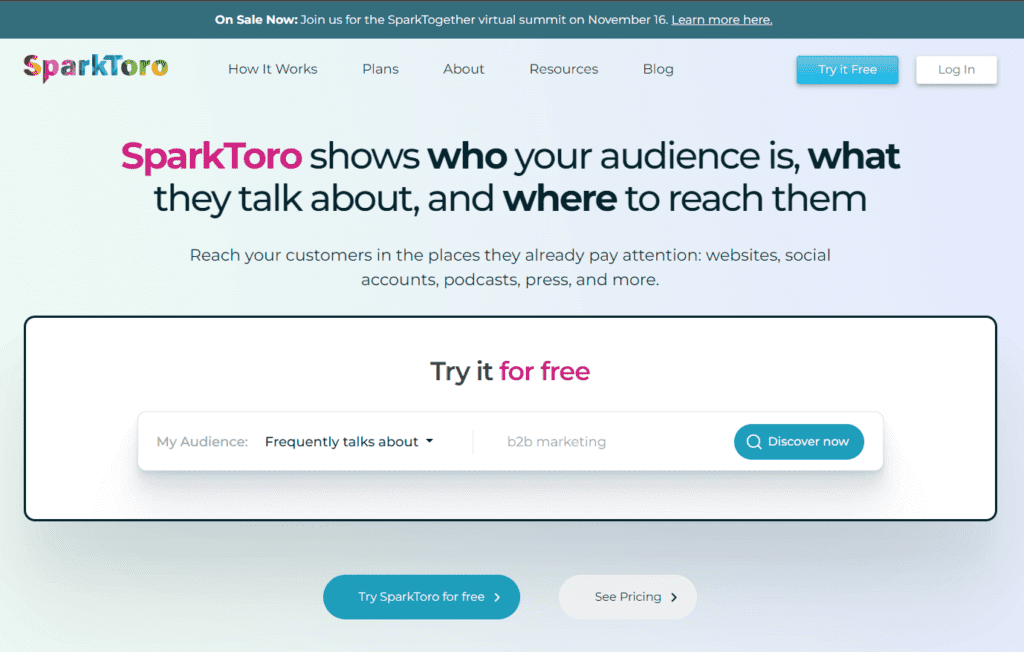

A tool like SparkToro will help you organize, clean, and interpret the information you’ve collected from all these sources. The software makes it easier for you to glean patterns, trends, and correlations that can inform your online course design.
If you have an existing audience, tools like these can also help you analyze data from your website, blog, email campaigns, and previous courses to get insights into the behavior and preferences of your current learners.
You’ll see metrics like page views, click-through rates, and course completion rates to gain deeper insights into your existing audience.
With that said, here’s a step-by-step guide on how to analyze the data you’ve collected:
- Data Collection Consolidation: First, gather all the data you collected during your audience research, including survey responses, forum discussions, direct messages, and any other sources.
- Categorize and Organize: Organize your data into categories or themes. Common categories might include pain points, goals, preferences, questions, challenges, and demographics. This helps you see patterns and identify key insights.
- Quantitative vs. Qualitative Data: Distinguish between quantitative data (e.g., survey responses with numerical values) and qualitative data (e.g., open-ended responses, quotes, and comments). You’ll analyze these types of data differently.
- Quantitative Data Analysis: For quantitative data, calculate descriptive statistics such as averages, percentages, and frequency distributions. This can help you identify trends and preferences within your audience.
- Qualitative Data Analysis: Qualitative data analysis involves summarizing and categorizing open-ended responses. You can use various qualitative data analysis methods, such as content analysis or thematic analysis, to identify recurring themes, quotes, and insights.
One important thing to keep in mind as you analyze your data: focus on identifying key insights. These could be recurring pain points, common goals, specific challenges, or unique preferences that your audience shares.
Identify Trends, Pain Points, and Common Goals
Identifying key insights from audience data is essential for making informed decisions in various fields, including content creation, product development, and marketing. Identifying your target audience’s pain points will help you create relevant, helpful, and engaging content for your course.
Furthermore, you can use the pain points as the main highlight in your online course sales copy for more effective marketing.
Here are some questions to ask yourself while analyzing your data:
- Is your target audience mostly located in a specific country?
- What language do they speak?
- Are they mostly female, male, or evenly represented?
- Which age range do they fall within?
- What is their level of education?
- Are there any other similarities or identifying characteristics in the group?
Once you’ve noted the recurring trends, common pain points, and areas where your potential learners are seeking solutions, you are now in a better position to tailor your course content to address these specific needs.
At this point, you have all the information you need to know about your online audience, including:
- Demographics: Such as age, gender, profession, primary language, educational background, etc.
- Psychology: Mental makeup, belief systems, likes, and dislikes.
- Group Characteristics: Traits shared by the group of learners (level of expertise, geographical location, etc.)
- Context: Where your learners are on their path, and what they hope to achieve with the help of your course.
You also have a clear understanding of:
- Audience Expectations: Why are learners taking your course? What concerns do they expect your course to solve? What do they expect to be able to do at the end of your course?
- Learning Preferences: How do your students like to learn? What motivates them to learn? Which media do they prefer – video tutorials, PDFs, slides, or audio? Do they like being engaged with and talked to?
Of course, there may be other considerations depending on the type of course you want to create. An example of one such consideration is entry behavior.
Entry behavior refers to the necessary knowledge or skills that learners must possess before they can master your course content. If they don’t possess the skills, it will be difficult to meet the learning objectives successfully.
Note that these skills aren’t always directly related to your online course. For example, a course on advanced web design obviously requires learners to know how to operate a computer.
However, it may still be necessary to ensure that the audience has the basic skills to use a computer if you are teaching a simulations-based training program that may require learners to understand complex commands that may come up on the screen.
Important Note: Prioritize and segment your data.
Prioritize the insights based on their relevance and significance. You may find that certain pain points or needs are more common or urgent than others. Segment your audience based on these insights to create targeted content and marketing strategies.
Step #4: Create Audience Personas
Now that you have a clear picture of who your target audience is, your next step is to develop audience personas based on the data.
Audience personas are fictional representations of typical members of your target audience. They are detailed profiles that include demographic information, as well as things like needs, preferences, and pain points.
When starting out, focusing on one persona is more than enough to prove marketing success. However, you may need to target additional personas if you have solutions that are vastly different and target specific buyers.
Personas can help you empathize with your learners and understand their needs better, and the more detailed the description, the better able you’ll be to identify your ideal learners online and determine the type of content that will work for each segment of your audience so they learn according to their capabilities.
Make sure each persona you create includes the following information on your ideal customer:
- Name
- Photo/avatar
- Age
- Gender
- Marital status
- Location
- Hobbies and interests
- Education level
- Profession
- Income
- What they read/watch
- Who they trust
- Their goals
- Their challenges
With the level of data you’ve amassed, you might find it difficult to figure out the best way to compile it all into a single coherent document. That’s where tools like HubSpot’s Make My Persona come in.
You can use this free persona generator to easily build a comprehensive buyer persona. There are templates designed for every campaign that will allow you to supercharge your segments and target your audience effectively based on the data you’ve collected.
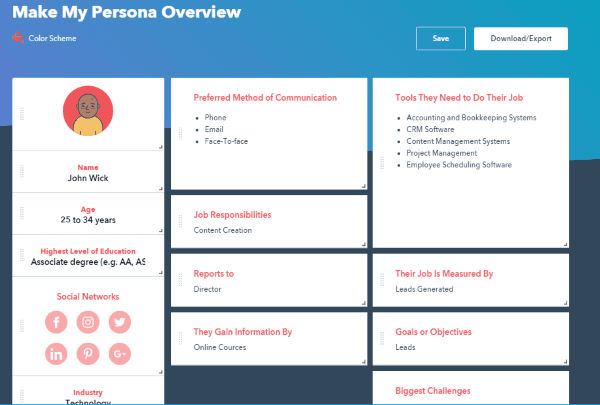

Once your persona(s) are created, you can also use them to define a unique selling proposition.
It will become clear how your course will deliver value to the learners in terms of knowledge, skill, and goal enhancement.
Step #5: Do Keyword Research
Now that you know your ideal audience, it’s a lot easier to find them and perform keyword research to figure out the terms they are searching for.
This is your final step in your audience research and it helps you identify the search terms and topics that your target audience is interested in. You can use this information to help you create relevant course content.
If you have ever typed a question into Google or any other search engine, such as “How to increase organic traffic to my website,” and clicked on whichever result seemed to provide the best answer, then you have been on the other end of the same process. The questions and search terms you used are keywords.
Now, you need to find the same keywords that your potential learners will use to find your course. You’ll also use them to develop your course material and even use some of them word for word within your course content to boost your search engine optimization efforts.
Use Google Keyword Planner, Ahrefs, SEMrush, or other keyword research tools to research high-volume, high-intent keywords, and phrases people search when looking for solutions like the one you provide.
Make a list of these keywords related to your course topic. Identify the most common search terms and questions that potential learners use and you can use them to tailor your course to rank for these terms.
Conducting keyword research helps you establish what your target audience wants to learn from someone with your expertise and guides your plans before you dive into the content creation process.
This way, you’ll be able to build an offering around the confirmed needs of potential learners, which means you’ll have a ready-made audience to fuel your success as an online course creator.
Step #6: Conduct Ongoing Research
Developing a viable course is a balancing act between the time you spend in the design & production phase, and the data you collect once your online course goes live.
However, in this case, the more information you gather about your audience, the better your results will be once you launch your course.
But your work doesn’t stop there.
Ongoing audience research is one of the keys to success in selling online courses. Audience preferences and behaviors may change over time, which is why you need to continuously gather feedback from your learners and stay updated on industry trends to ensure your courses remain relevant and engaging.
Continuing to learn about your audience even after launching your course will also help you make informed decisions and build stronger connections with your intended audience – even as trends change.
Remember that the depth of your research and the specific methods you use will depend on your course’s niche, target audience, and available resources.
Develop Your Content
Now you’re ready to use the insights from your research to shape your course content. Create modules or lessons that directly address the questions and challenges you’ve identified and incorporate the keywords from step #5.
Engage Your Community
As you develop your course, share your progress and ask for feedback from the same forums and groups. This not only helps you refine your content but also generates interest and potential early enrollees.
Create a Feedback Loop
Continuously engage with your audience, even after your course is launched. Gather feedback, address any emerging questions or concerns, and use this feedback to improve your course for future iterations.
Wrapping Up
There you have it—the ultimate guide to audience research for course creators. Follow the steps outlined in this article to define your target audience in a systematic, data-driven way so you can find a problem worth solving and create an online course or other educational offering your learners will love.
FAQ
How do you conduct audience research?
There are many ways to conduct audience research. One of the simplest ways is to create surveys or polls and share them on your website, social media, or in emails. You can also interview people one-on-one or use focus groups to get deep insights into what the audience wants.
What are the two main types of audience research?
The two main types of audience research involve quantitative and qualitative data. Quantitative data deals with numbers and quantities, such as statistics, and qualitative data involves an in-depth analysis of the opinions of your audience and the reasons they behave as they do.
What are the most common ways to conduct audience research?
Among the many methods of audience research, some of the most commonly used ways include surveys, interviews, social media monitoring, and keyword research into the topics being searched by the target audience.
How do you analyze the target audience in e-learning?
The best way to analyze the target audience in e-learning is to focus on the challenges they face. Being able to identify your audience’s pain points will help you create relevant content and targeted marketing campaigns for optimal results.
What are the benefits of audience research for content creators?
Content creators can use audience research to inform their content creation strategies. They’ll be able to create content that is more targeted and engaging for each segment of the audience which, in turn, helps to build stronger connections and boost engagement levels.
What’s the best way to create a customer persona for an online course?
The best way to create a digital customer persona is to use a dedicated tool like “Make My Persona” from HubSpot. It comes with predesigned templates, and all you have to do is input the information you collected during your audience research, and the software will create a detailed persona, complete with an avatar and analysis for marketing purposes.
